This was published 6 years ago
Bourke's Mary Matthew monument: Stranger than fiction
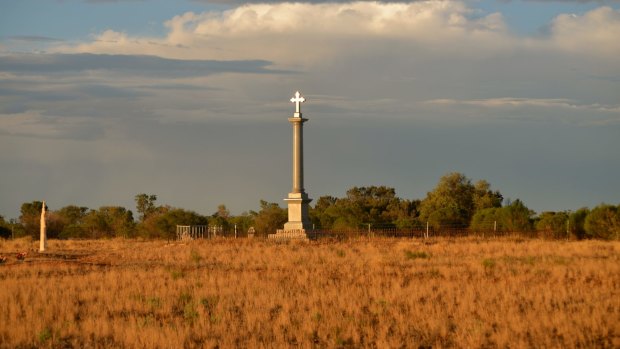
Love always: The Mary Matthews monument in Louth. Credit: thelandy.com
It's an enduring love story that a small town bears witness to each night.
Just on dusk when the sun's last rays bear down on Louth in far-western NSW (population "around 100"), a beam hits a 7.6 metre granite monolith on a grave site in the historic cemetery, casting an ethereal glow across the town.
The monument, to local woman Mary Mathews, 42, was erected in 1886 – 17 years after her death – by her husband, Thomas, who appears to have never recovered from the loss of the mother of his six children.
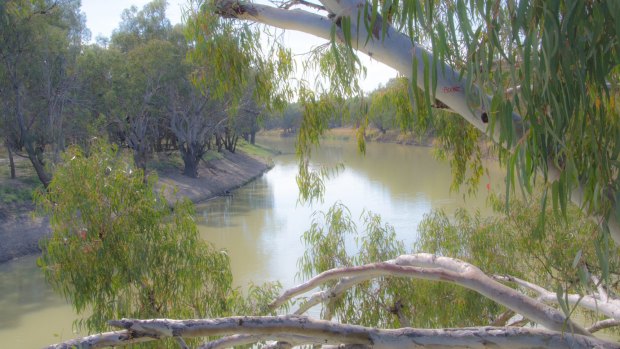
The Darling River, near Bourke.Credit: iStock
But it's what happens each year on August 19 – the date Mary finally succumbed to a lung disease – that is even more heart-wrenching. In a testament to physics, astronomy and enduring love, when the sun hits the cross on this day it casts a beam of light directly to the door of the house they used to share.
I remember standing with friends by the monument, all of us momentarily struck dumb (something that doesn't happen often) by its sheer scale and beauty. We had spent the past week travelling around Bourke and Brewarrina to research a novel we were writing together*, and we kept encountering things that turned our imagined ideas of the area upside down, and this was one of them. Who knew that such a remote place could house such a romantic and enduring love story?
Fact was indeed stranger than fiction, we agreed. And then it got stranger.
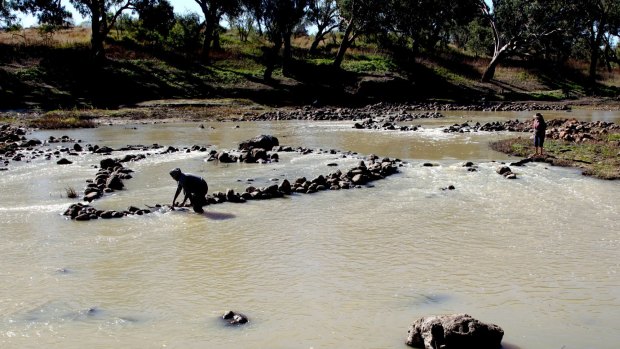
The Brewarrina fish traps on the Barwon River and also known in the local Aboriginal language as Ngunnhuare are estimated to be over 40000 years old. Credit: Edwina Pickles
On closer inspection of the monument another name was mentioned – there was a second wife. And here the story becomes more intriguing.
As mentioned, Mary's death had left Thomas with six children. And while he was doing quite well financially by this time, Louth, being literally in the back of Bourke, was – still is – isolated. Life could be hard and lonely out there, and there is little doubt Thomas was struggling without Mary. Two years after her death he married Victorian woman, Mary Larkins, aged just 22. I picture her arriving in the searing heat in her uncomfortable long dresses and corsets, and seeing the flat expanse of nothing on the horizon in every direction. Who knows what trials faced that young woman after she arrived at this outpost, so far from home? But whatever they were, they proved to be too much: she died three months later – from self-inflicted strychnine poisoning. Did I mention life was tough out here?
Yet in a testament to Thomas's belief in love and possibly also to his loneliness, two years later he married again. At the age of 47 he wed Susan Raey, a 33-year-old widow with five children. Yet his first wife must have not been far from his thoughts, because it was while he was married to Susan that he started planning the memorial. Yes, his third wife must have been one understanding woman, for Thomas spent several years and a fortune transporting the materials for the memorial to the Louth cemetery and when the monolith was finally in place, Susan presided with her husband over a banquet held to mark the occasion. Here a toast was made to Thomas' dead wives and to Susan's "continued health". (Susan died 18 years later in 1891 and four years later Thomas Mathews married Clara Childs, 41, an English widow. She became his fourth – and final – wife.)
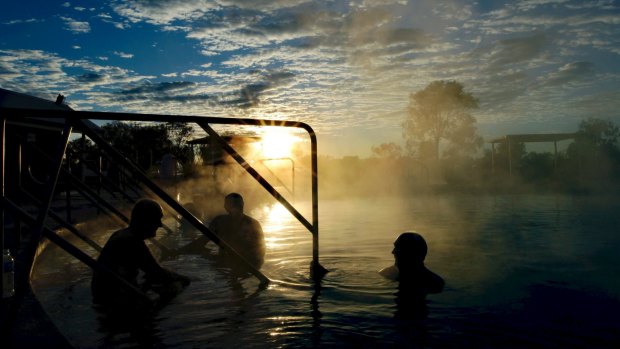
Lightning Ridge Bore Baths at sunrise. Credit: Edwina Pickles
You couldn't make this stuff up, which was really why we had travelled to Bourke and beyond in the first place. We were "making stuff up" for a novel, but we wanted it to have a ring of truth. So what did we learn? Well, for a start, there were the practical things that we realised we had very wrong about the place where our story was set. The soil was grey/black – not red; people didn't tend to sweat in such a dry heat as they would in Sydney so we had to "de-sweat" the book. And the landscape we had imagined to be flat, dry and monotonous was, in fact, strikingly beautiful. But the main thing we learned was that everywhere has hidden stories of great love and great loss that are just waiting to be uncovered.
*The Painted Sky (2015) and The Shifting Light (Bantam Australia $32.99) by Alice Campion
FIVE MORE MUST SEES
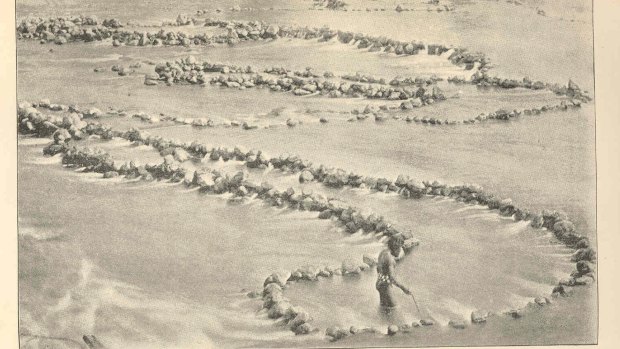
Historic pics of the fish traps.Credit: Alamy
BREWARRINA FISH TRAPS
These rock weirs and pool carvings in the river were forged by ancient tribes and are believed to be more than 40,000 years old – making them one of the oldest man-made structures on Earth. These are, well, gobsmacking. And it's actually embarrassing that they are not more well known. See visitnsw.com
ANCIENT ART AT GUNDABOOKA NATIONAL PARK
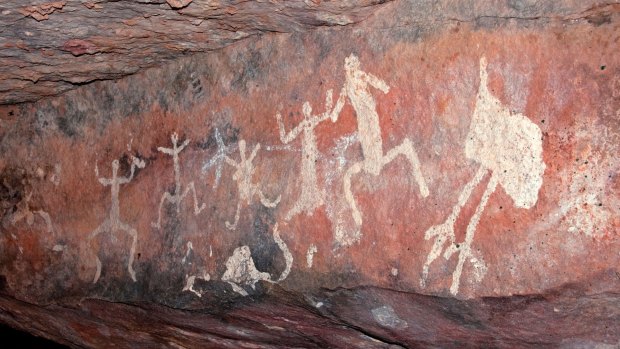
Aboriginal rock art on wall of cave at Gundabooka National Park, north-western NSW.Credit: Alamy
You don't have to travel to the Northern Territory or the Kimberley to see ancient rock art. Kangaroos, dancing figures and handprints seem to shimmy in the sun at the Mulgpowan (Yapa) rock art site in Gundabooka National Park just outside Bourke. See visitnsw.com
THE GLENGARRY HILTON
No danger of mixing this watering hole up with its counterpart in George Street, Sydney, but this rambling structure on the Glengarry Opal Site 70 kilometres west of Lightning Ridge has its own particular charms. There's cold beer, seating in the shade, and plenty of interesting locals and travellers to keep you entertained – possibly for hours.
ARTESIAN BORE BATHS, LIGHTNING RIDGE
Some find these baths the best way to de-stress, some say they are refreshing, others swear they have healing properties. When you consider the waters come direct from the Great Artesian Basin and are about two million years old, there may be something in that. See lightningridgeinfo.com.au
HOSPITAL CREEK MEMORIAL
Here is another true tale, but this one is much harder to tell. This small stone memorial erected by the local Aboriginal Land Council is almost hidden by long grass by the side of the Goodooga Road, 15 kilometres from Brewarrina. Blink and you'll miss it, and that would be a shame because it stands in memory of as many as 400 Indigenous people who were rounded up and shot there. Some say this mass homicide happened after a dispute over the killing of a steer; others say the killings were in retaliation after it was feared a missing European stockman had been speared, and yet others say it occurred after a white settler was killed when he refused to release an Aboriginal woman. This simple monument is sobering and stands in stark contrast to the massive edifice mentioned at the top of this story.
TRIP NOTES
FLY
Rex Airlines flies direct to Cobar, about one hour and 40 minutes' drive to Bourke, see rex.com.au Or Rex and Qantas fly regularly to Dubbo – about a 4½-hour drive. Qantas.com.au
Jane Richards travelled at her own expense.
Sign up for the Traveller Deals newsletter
Get exclusive travel deals delivered straight to your inbox. Sign up now.